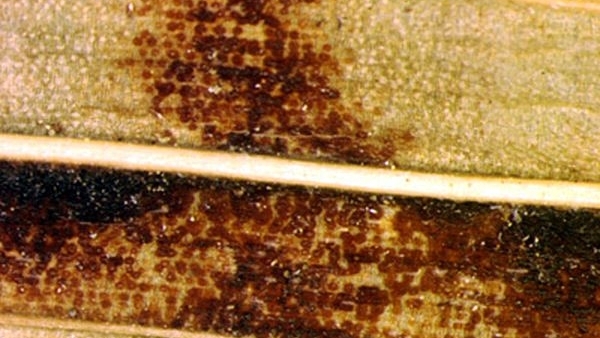Gladiolus Rust

Gladiolus rust is a plant disease caused by several fungi, including Uromyces transversalis, Puccinia gladioli, Puccinia mccleanii, Uredo gladioli-buettneri, Uromyces gladioli, and Uromyces nyikensis. The fungus Uromyces transversalis is established in the United States. The others have not been found in this country and pose a concern for growers and homeowners.
Airborne spores from these fungi can travel long distances via wind, on plant cuttings such as flowers and stems, and on the surface of corms (a bulb-like part of the plant stem that grows underground). The pathogen causes stress to plants in the gladiolus family.
With their vibrant colors and long, pointed leaves, gladioli are eye-catching plants. Unfortunately, they can succumb quickly to disease. Are your gladioli infected? Here's what to look for:
- Yellow spots
- Small yellow spots form on either side of the gladiolus leaves. These spots eventually grow, developing into yellowish-orange blisters measuring 1mm x 1cm.
- Damaged tissue
- The blisters grow and merge to form larger patches of damaged tissue.
- Always buy plants from reputable growers.
- Report any signs of gladiolus rust to your State plant health director or State plant regulatory official. They will determine if it is caused by a pathogen regulated by USDA and take necessary steps to control it, if needed.
Homeowners and commercial growers should work with their State plant health director or State plant regulatory official to determine what species of rust is on the plants before attempting any control measures.
Report Plant Pests and Diseases
Have you seen this pest or signs of pest damage? Immediately report your findings.
Find your State plant regulatory official
Find your State plant health director
Controlling Gladiolus Rust
After years of eradication efforts, APHIS decided it would no longer take action at ports of entry nor would it require State partners and industry to take action when Uromyces transversalis is found in commercial growing areas, domestic commerce, or in residential areas.
By making these changes, APHIS and State plant regulatory officials have been able to focus resources on other more serious pests. These changes have also allowed APHIS to remove burdensome requirements from growers and homeowners, who were often forced to destroy plants infected with Uromyces transversalis.
APHIS continues to regulate other gladiolus rust pathogens that are not known to occur in the United States, including Puccinia gladioli, Puccinia mccleanii, Uredo gladioli-buettneri, Uromyces gladioli, and Uromyces nyikensis. APHIS also continues to serve as a technical resource for gladiolus rust.
Learn more: APHIS Revises Response to Domestic Detections of Gladiolus Rust caused by Uromyces transversalis (30.48 KB)

